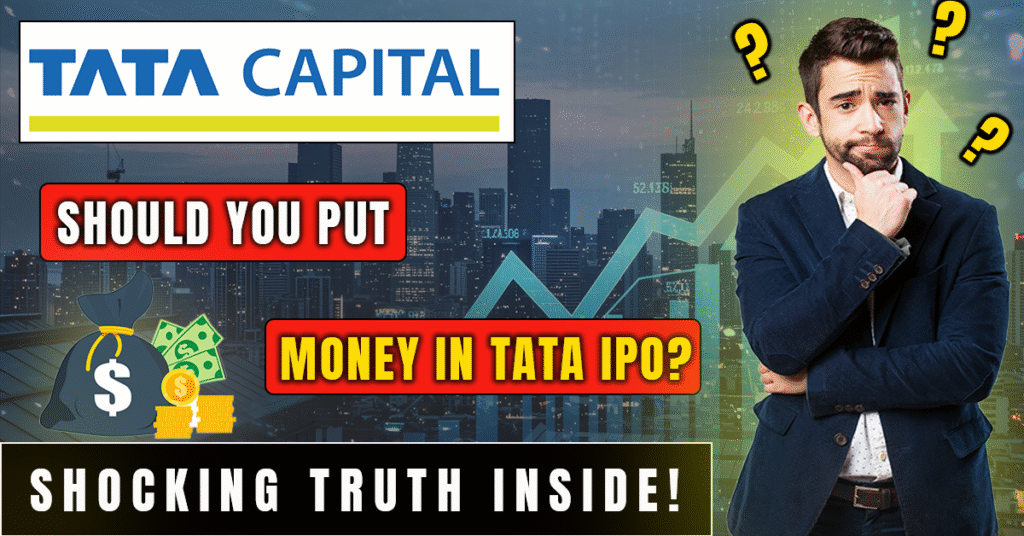
Tata Capital IPO is a mammoth buzz with a price of 15,500 crores, being the largest IPO in 2025, and it is a turning point for the non-banking financial sector (NBFC) and the retail investors. The size, lineage and timing of the offering by the parent company have attracted views of leading financial analysts and investment banks, with some giving conflicting views on the investment analysis, although the majority concurred on the long-term potential of the company.
Key technical indicators:
| Technical Indicator | Value | Comments |
| P/E Ratio (Price to Earnings) | 35.99 | Indicates valuation relative to earnings |
| Earnings Per Share (EPS) | ₹9.06 | Profit attributed to each share |
| Return on Net Worth (RoNW) | 11.2% | Profitability relative to shareholder equity |
| Return on Equity (ROE) | 12.6% | Measure of profitability for equity holders |
| Price to Book Value (P/B) | 4.10 | Market price relative to net asset value |
| Market Capitalization | ₹1,38,382.73 Crores | Total market value at IPO price |
| Grey Market Premium (GMP) | ₹7 to ₹10 per share | Shows expected listing gain percentage (approx. 2-3%) |
Tata Capital IPO: The Contours
Tata Capital is selling stocks at the price range of 310 to 332, and the minimum investment is 14996 on a lot of 46 shares. The IPO is organised at a fresh issue of 6,846 crore (that will boost corporate expansion and enhance Tier-I capital) and an offer-for-sale of 8,666 crore by existing shareholders Tata Sons and International Finance Corporation (IFC). The transaction will weaken the Tata Sons stake by about 11 per cent.
During Day 1, the IPO received approximately 1419% subscriptions, with the majority being institutional; Day 2 recorded over 52 per cent subscriptions, and this again supports the steady demand. The grey market premium (GMP) is a major sentiment indicator and has been trading between 7 and 13 per share, indicating listing gains of between 2 and 3 per cent, although significantly under the first market exuberance.
Financial Performance and Health
Financial performance Tata Capital has a good turnover: net profits increased to 3655 crore in FY25, compared to 3327 crore in the previous year. Revenue surged to ₹28,313 crore. As of June 2025, the total assets are 2.52 lakh crore, making it the third-largest diversified NBFC in the country after Bajaj Finance and Shriram Finance. Loan book has increased at a rate of 37 per cent CAGR during our last few years, having a growing retail, SME, and digital lending presence.
What Do Financial Experts Say?
Positive Long-Term Case
Anand Rathi: Interviews Tata Capital recommends Subscribe Long term, with a focus on the size of the company, risk management, and digital transformation as its advantages. They believe they have participated in the IPO at the upper price band (P/E of 32.3x, P/B of 3.5x), yet they want to participate in the long term owing to plausible growth opportunities.
Mehta Equities: Likes Tata Capital to play on the growing credit space in India due to brand strength, diversified lending and price at a reasonable level relative to other companies in the industry. They particularly point to a strong financial performance and a good image of the company as the reasons for a long-term purchase recommendation.
Choice Broking: The IPO is justified because Tata Capital has been leading in the market with its steady growth and market reputation, which are expected to remain relevant in the NBFC industry.
Cautious or Neutral Outlook
Deven Choksey Research: Agrees with a Rating of Neutral that the price-to-book (P/B) multiple is 4.1x, higher than the industry average of 3.7x; margins and profitability are thinner. They perceive fair value, though they advise investors to be cautious of short-term expectations.
ICICI Direct: Praises the sound management and capital base of Tata Capital but does not rate it specifically, as the nature of the offer is of concern.
SBI Securities warns that it can be priced fairly, but the Tata Motors Finance merger may impose a strain on their short-term profitability; they do view long-term strengths.
Canara Bank Securities: The company says that the IPO has been priced on par with the peers and that digital transformation and economic tailwinds will drive the company upwards, but that there are integration, interest rate and regulatory risks.
Key Reservations Highlighted
Experts caution about:
- Margins and return on assets (RoA) are lower than some leading NBFC peers.
- The subdued GMP reflects a more sober market environment, less hype, and a focus on fundamentals amid tighter IPO pricing.
- Potential headwinds from merger integration and external macro risks.
Investor Sentiment and Market Outlook
Despite tempered GMP, investor psychology remains positive—buoyed by Tata’s legacy, anchor investments from blue-chip institutions (LIC, Goldman Sachs, Nomura, and Morgan Stanley), and a strong financial foundation. The IPO’s steady subscription and the brand’s trustworthy reputation add to long-term confidence. i
Should Retail Investors Buy?
- For long-term investors seeking exposure to India’s NBFC growth story and the stability of the Tata brand, most brokerages recommend subscribing, particularly for those with multi-year horizons.
- For short-term or high-GMP seekers, the IPO may offer limited immediate upside, as pricing already reflects considerable optimism and broader NBFC sector risks remain.
Pros of Tata Capital IPO
- Well-established Brand Support: Lending credibility and trust as a Tata Group.
- Strong Financial Results: Stable growth in revenues and profits at a 37% CAGR in the loan book.
- Diversified Lending Portfolio: The retail, SME, and digital lending segments decrease the concentration of risk exposure.
- Long-Term Growth Potential: It is the third-largest diversified NBFC in India, which has an available growth potential.
- Confidence of Anchor Investors: Institutional support by institutions such as LIC, Goldman Sachs and Morgan Stanley.
Cons of Tata Capital IPO
- Premium Valuation: P/E (c. 36x) and P/B (more than 4x) are higher than some NBFC peers and can restrict short-term returns.
- Moderate Listing Gains: GMC is associated with small listing gains, which is indicative of a risk-averse market.
- Margin Pressure Risks: Increasing funding costs and provisioning buffers would affect profitability.
- Merger Integration Problems: Tata Motors Finance: Combining with Tata Motors Finance may cause short-term operational complications.
- External Macroeconomic risks: Future performance may be subject to changes in interest rates and regulatory changes.
Conclusion
The Tata Capital IPO is not only large but also characterised by the combination of good fundamentals, average listing returns and a believable long-term growth track. There is a consensus among financial community analysts that Tata Capital is a strong player in the diversified lending environment; however, they advise caution over valuation and peer benchmarking. The general mood is ‘Subscribe – Long Term’ – this is the opinion prevalent in well-known research houses and among market strategists.
Disclaimer: The information provided in this article, “Should You Invest in Tata’s Latest IPO? Expert Insights & Market Buzz,” is intended solely for educational and informational purposes. It does not constitute financial or investment advice. Readers are encouraged to conduct their own research or consult a qualified financial advisor before making any investment decisions. The author and Stofiniq are not responsible for any financial losses or outcomes resulting from actions taken based on this content.
A digital marketer possessing excellent knowledge and skill in off-page, on page and local SEO is competent in the challenging environment. Hard-working, energetic, and a quick learner for any task delegated. Enthusiastic to learn and constantly upgrade knowledge. Mohit brings over 2 years of experience in crafting content that not only ranks well but also provides valuable insights to readers.

